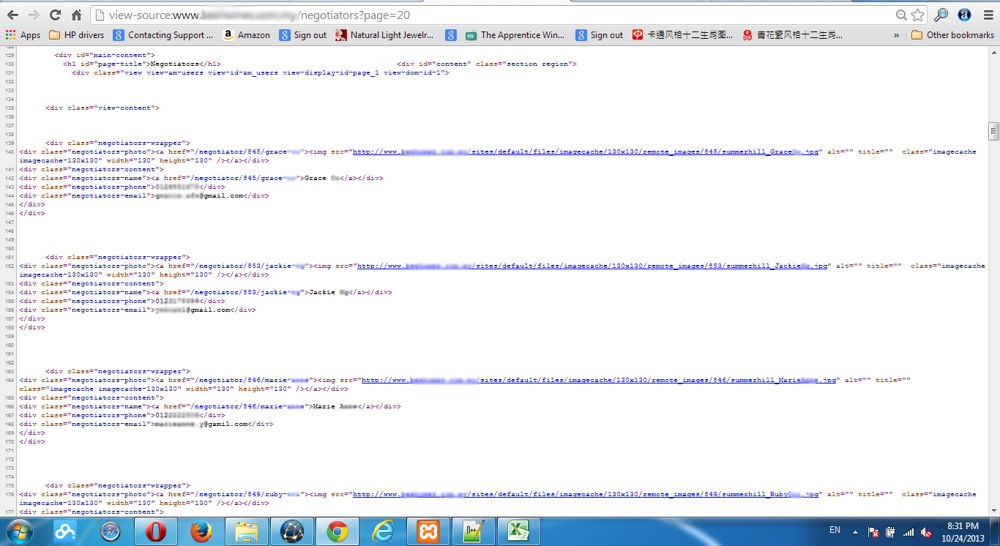
在本文里,我将解释如何使用PHP/cURL从网页提取Email地址。PHP脚本将运用正则表达式匹配HTML标签提取。
想想看,如果我们寄出电邮开头以“先生您好”或“老板您好”,那收信者多数会把我们的邮件当成垃圾处理。所以使用网络爬虫或蜘蛛采集Email地址时,我们也需提取相关的资料如姓名,电话号码,公司名称,职位等。把这些资料包括在邮件内容,收信者就会仔细阅读。
当然,请您不要滥用海量采集电子邮件地址的能力,胡乱发出垃圾邮件,令人反感的广告内容,违反版权法或干扰网络带宽。如果您惹祸上身,小弟没有势力救不了您,还是请个律师帮忙好。
首先,我们看看一个简单的电邮地址提取脚本。之前的HttpCurl类将会被使用。
<?php
define('EMAIL_PATTERN', '/([\s]*)([_a-zA-Z0-9-]+(\.[_a-zA-Z0-9-]+)*([ ]+|)@([ ]+|)([a-zA-Z0-9-]+\.)+([a-zA-Z]{2,}))([\s]*)/i');
interface HttpScraper
{
public function parse($body, $head);
}
class Scraper implements HttpScraper
{
public function parse($body, $head) {
if ($head == 200) {
$p = preg_match_all(EMAIL_PATTERN, $body, $matches);
if ($p) {
foreach($matches[0] as $emails) {
echo "<pre>";
print_r($emails);
echo "<pre>";
}
}
}
}
}
class HttpCurl {
protected $_cookie, $_parser, $_timeout;
private $_ch, $_info, $_body, $_error;
public function __construct($p = null) {
if (!function_exists('curl_init')) {
throw new Exception('cURL not enabled!');
}
$this->setParser($p);
}
public function get($url) {
return $this->request($url);
}
protected function request($url) {
$ch = curl_init($url);
curl_setopt($ch, CURLOPT_FOLLOWLOCATION, TRUE);
curl_setopt($ch, CURLOPT_MAXREDIRS, 5);
curl_setopt($ch, CURLOPT_RETURNTRANSFER, TRUE);
curl_setopt($ch, CURLOPT_URL, $url);
$this->_body = curl_exec($ch);
$this->_info = curl_getinfo($ch);
$this->_error = curl_error($ch);
curl_close($ch);
$this->runParser($this->_body, $this->getStatus());
}
public function getStatus() {
return $this->_info[http_code];
}
public function getHeader() {
return $this->_info;
}
public function getBody() {
return $this->_body;
}
public function __destruct() {
}
public function setParser($p) {
if ($p === null || $p instanceof HttpScraper || is_callable($p))
$this->_parser = $p;
}
public function runParser($content, $header) {
if ($this->_parser !== null)
{
if ($this->_parser instanceof HttpScraper)
$this->_parser->parse($content, $header);
else
call_user_func($this->_parser, $content, $header);
}
}
}
?>
如何操作:
1. 首先定义一个正则表达式匹配电子邮件的格局。这模式将只在这个例子中使用。我们将在下一篇文章中改变模式。
define('EMAIL_PATTERN', '/([\s]*)([_a-zA-Z0-9-]+(\.[_a-zA-Z0-9-]+)*([ ]+|)@([ ]+|)([a-zA-Z0-9-]+\.)+([a-zA-Z]{2,}))([\s]*)/i');
2. 然后定义称为HttpScraper的接口,内含一个公共方法parse().
interface HttpScraper
{
public function parse($body, $head);
}
3. 下一步,我们创建一个类Scraper实现上述接口。有两个信息将传递给parse()的函数,一个是网页内容,另一个是该网页头部的HTTP_CODE。如果$head的值是200,我们使用功能preg_match_all在网页内容进行匹配电子邮件地址的格局(EMAIL_PATTERN)。在本教程中,我们在屏幕上打印结果。
class Scraper implements HttpScraper
{
public function parse($body, $head) {
if ($head == 200) {
$p = preg_match_all(EMAIL_PATTERN, $body, $matches);
if ($p) {
foreach($matches[0] as $emails) {
echo "<pre>";
print_r($emails);
echo "<pre>";
}
}
}
}
}
4. 这里可看到HttpCurl被修改的部份。
class HttpCurl {
protected $_cookie, $_parser, $_timeout;
private $_ch, $_info, $_body, $_error;
public function __construct($p = null) {
if (!function_exists('curl_init')) {
throw new Exception('cURL not enabled!');
}
$this->setParser($p);
}
public function get($url) {
return $this->request($url);
}
protected function request($url) {
$ch = curl_init($url);
curl_setopt($ch, CURLOPT_FOLLOWLOCATION, TRUE);
curl_setopt($ch, CURLOPT_MAXREDIRS, 5);
curl_setopt($ch, CURLOPT_RETURNTRANSFER, TRUE);
curl_setopt($ch, CURLOPT_URL, $url);
$this->_body = curl_exec($ch);
$this->_info = curl_getinfo($ch);
$this->_error = curl_error($ch);
curl_close($ch);
$this->runParser($this->_body, $this->getStatus());
}
public function getStatus() {
return $this->_info[http_code];
}
public function getHeader() {
return $this->_info;
}
public function getBody() {
return $this->_body;
}
public function __destruct() {
}
public function setParser($p) {
if ($p === null || $p instanceof HttpScraper || is_callable($p))
$this->_parser = $p;
}
public function runParser($content, $header) {
if ($this->_parser !== null)
{
if ($this->_parser instanceof HttpScraper)
$this->_parser->parse($content, $header);
else
call_user_func($this->_parser, $content, $header);
}
}
}
5. 我们在HttpCurl的建構子加了成員函數setParser()。这函數把传递至$p的对象或回调函数存储在$_parser.
public function setParser($p) {
if ($p === null || $p instanceof HttpScraper || is_callable($p))
$this->_parser = $p;
}
6. 我们在类HttpCurl加了函數runParser()。runParser()执行$_parser里的对象或回调函数。我在这文章里使用对象。
public function runParser($content, $header) {
if ($this->_parser !== null)
{
if ($this->_parser instanceof HttpScraper)
$this->_parser->parse($content, $header);
else
call_user_func($this->_parser, $content, $header);
}
}
7. runParser()函數在 request()的cURL请求网页源文件后才执行。
protected function request($url) {
$ch = curl_init($url);
curl_setopt($ch, CURLOPT_FOLLOWLOCATION, TRUE);
curl_setopt($ch, CURLOPT_MAXREDIRS, 5);
curl_setopt($ch, CURLOPT_RETURNTRANSFER, TRUE);
curl_setopt($ch, CURLOPT_URL, $url);
$this->_body = curl_exec($ch);
$this->_info = curl_getinfo($ch);
$this->_error = curl_error($ch);
curl_close($ch);
$this->runParser($this->_body, $this->getStatus());
}
神兵降世,饮血开锋,现在我们可试试新脚本了。
如果您开发了产业网站,并已放在网上,您需要产业代理注册成会员上传他/她们的产业。要通过搜索引擎找到您的网站是非常困难的事。我们可通过别的网站找到他们的联络方法,采集后可发邮件邀请他/她们进入您的网站。以下有的简单例子。

在网页源文件,就可看到HTML代码。

现在修改我们的test.php
<? php include 'httpcurl.php'; $target = "http://目标域名"; $up = new Scraper; $test = new HttpCurl($up); $test->get($target); ?>
执行后可看到脚本提取到电邮地址了。

先别开心,因为我们还没有提取到别的资料,如名字和电话号码。下一章我们只需稍微修改脚本就可达到目的。

